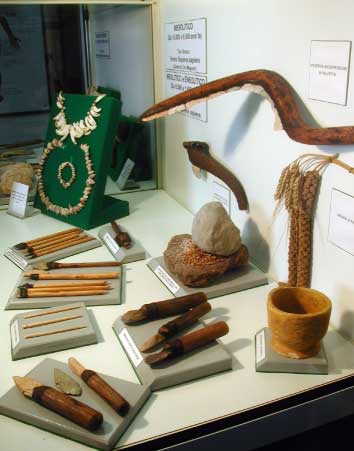Palaeontology and Human Anatomy
The multipurpose room with the exhibits of palaeontology and human anatomy is at the moment also used for lectures.
The recent archaeological finds in Alpago are expected to be displayed here.
Palaeontology
The display case entitled “Prehistoric Archaeology” contains some reconstructions of tools used by primitive man in the early Palaeolithic period (over 100,000 years ago), including cutting stones and spear heads made from sharpened flint.
From the middle Palaeolithic period (between 40,000 and 100,000 years ago, the period of Neanderthal man or Homo Sapiens) there are other weapon heads, hooks and harpoons made of horn and bone.
From the late Palaeolithic period (between 10,000 and 40,000 years ago, the period of Homo Sapiens sapiens or the Cro-Magnon man) there are various tools for domestic and agricultural use and the first terracotta bowls for holding food. These artefacts were improved in successive periods: the Mesolithic (between 6,000 and 10,000 years ago), the Neolithic and Aeneolithic (between 1,800 and 6,500 years B.C.).
On the wall panels scenes in the daily life of primitive man in different prehistoric periods are depicted, as well as the characteristics and appearance of the first hominoids up to modern man.
Human Anatomy
An entire wall is dedicated to Human Anatomy with a series of large panels illustrating the muscular-skeletal system, both superficial and in depth, the cardiocirculatory and nervous systems. For teaching purposes there are also a natural sized human skeleton and models of the main human organs which can be taken apart.

